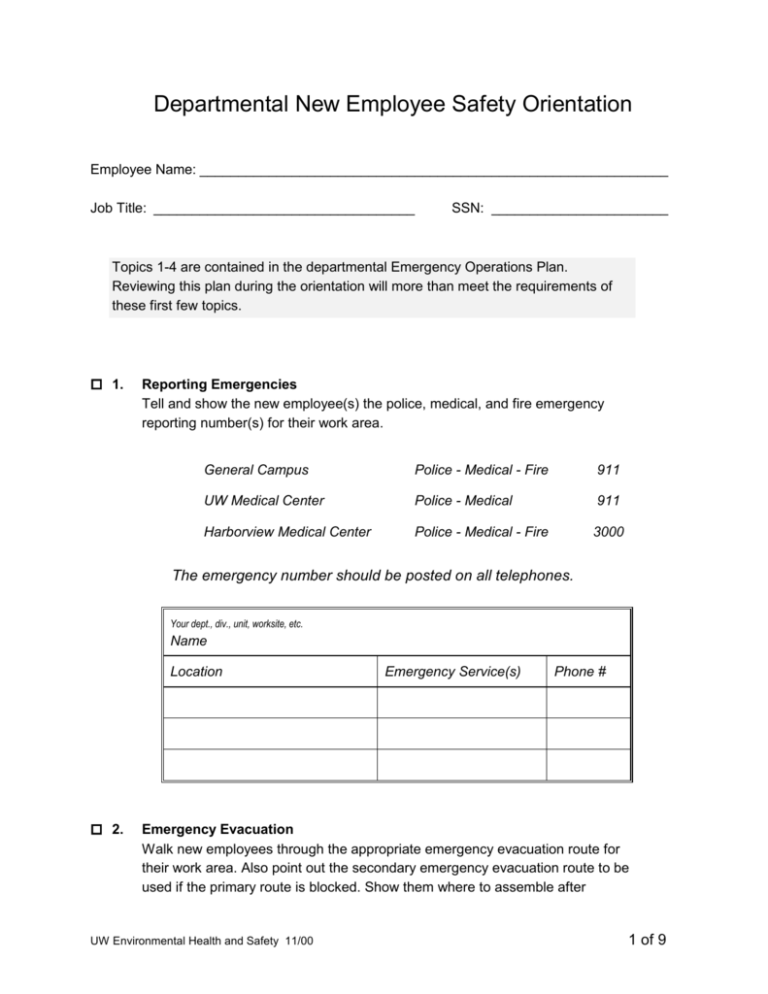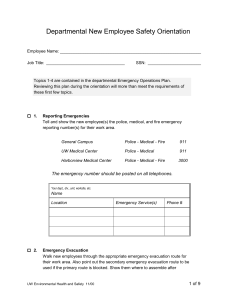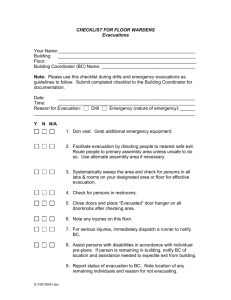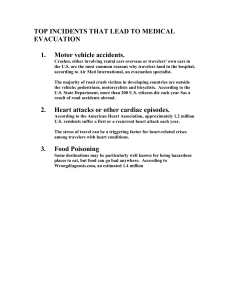New Employee Safety Orientation
advertisement

Departmental New Employee Safety Orientation Employee Name: _____________________________________________________________ Job Title: __________________________________ SSN: _______________________ Topics 1-4 are contained in the departmental Emergency Operations Plan. Reviewing this plan during the orientation will more than meet the requirements of these first few topics. 1. Reporting Emergencies Tell and show the new employee(s) the police, medical, and fire emergency reporting number(s) for their work area. General Campus Police - Medical - Fire 911 UW Medical Center Police - Medical 911 Harborview Medical Center Police - Medical - Fire 3000 The emergency number should be posted on all telephones. Your dept., div., unit, worksite, etc. Name Location 2. Emergency Service(s) Phone # Emergency Evacuation Walk new employees through the appropriate emergency evacuation route for their work area. Also point out the secondary emergency evacuation route to be used if the primary route is blocked. Show them where to assemble after UW Environmental Health and Safety 11/00 1 of 9 New Employee Safety Orientation Checklist evacuation. Discuss special evacuation needs and plans with disabled employees. (Campus building evacuation floor plans are available from EH&S, call 3-0465.) 3. 4. 5. Local Fire Alarm Signaling System Show new employees where fire alarm pull stations are and instruct them in their use. Let them know that activating the pull station sounds an alarm in the building to alert other occupants to evacuate. Describe what the alarm in your building sounds like ( a bell, chimes, a slow whoop). Tell your new employees that they must leave the building immediately upon hearing the alarm, closing doors behind them. When employees discover a fire they should first, pull the nearest fire alarm pull station and then exit the alarmed area. If possible, employees should follow up with a telephone call from a safe location to provide more details. On Campus: The activation of a fire alarm pull station also sends a signal to the UW Police and Seattle Fire Department showing the location of the emergency. Portable Fire Extinguishers Show the employee(s) where portable fire extinguishers are located. Tell them to use a portable fire extinguisher only if: they have been trained to use them, the fire alarm has been sounded first, the fire is small (waste basket size), and they have a clear evacuation route. Department Reporting Procedures Tell your new employee(s) to immediately report accidents, incidents, near misses, motor vehicle accidents and any unsafe conditions or acts to: Name: Phone: Location: Room: Environmental Health and Safety 11/00 2 of 9 New Employee Safety Orientation Checklist Usually their supervisor a. Reporting Accidents and Incidents Explain that after they immediately report on-the-job accidents, they have to fill out a University accident incident report form. Work Location Form University UoW 1428 UW Medical Center UH0266 Harborview Medical Center UH0266 Dental School UoW 1119 Your report form name Report form # Request form from Explain the form and tell them where the forms are located. All accidents or near accidents (incidents) must be reported on this form even if no personal injury was sustained. Reporting all accidents and incidents helps the University and the employing departments initiate effective safety programs and accident prevention measures. b. Reporting Motor Vehicle Accidents All automobile accidents in University-owned vehicles must also be reported to the University Police Department (911) immediately, whether or not there appears to be personal injury or property damage. c. Reporting Unsafe Conditions and Acts Along with immediately reporting unsafe conditions and acts to their supervisors or the person noted above, employees may report safety problems to Environmental Health and Safety. Explain that employees should take responsibility for correcting unsafe Environmental Health and Safety 11/00 3 of 9 New Employee Safety Orientation Checklist conditions when feasible, e.g., wiping up small, nontoxic spills and removing tripping hazards. 6. Workers’ Compensation and Industrial Insurance Tell employees that work-related injuries or illnesses resulting in medical expenses or time loss are covered by Washington State’s Workers’ Compensation. To establish a Workers’ Compensation claim, employees must fill out a State Department of Labor and Industries (L&I) Report of Industrial Injury or Occupational Disease at their medical provider’s office when they receive medical care for a work-related injury or illness. Explain, also, that prompt reporting of accidents to you, the supervisor, will make the claims process easier and may allow you to find them modified work during their recovery. 7. First Aid Tell new employees where first aid kits are located. If your department is required to have first aid certified employees on staff, (UW OPS D 10.5) tell new employees who they are and how to contact them. Explain what actions employees should take if they or others are injured. If safety showers or eye wash stations are located in your department, show new employees where they are and instruct them in their use. 8. Hazard Communication (Chemical Safety) (Worker Right-to-Know, HazCom) a. General (all employees) Tell new employees where hazardous materials are used or stored in their work area. Explain the labeling system for these materials. Show employees where material safety data sheets (MSDSs) are located or explain how they can obtain an MSDS. If new employees will be working with hazardous materials, tell them they will receive training in the safe handling of these materials or conduct the training at this time, if appropriate. Environmental Health and Safety 11/00 4 of 9 New Employee Safety Orientation Checklist Hazard Communication training is conducted by supervisors or a designated departmental trainer. Inform new employees that hazardous materials emergencies, such as spills or releases too big for them to clean up, are to be reported to: Who Phone Small Spills Large Spills or releases Report large spills or releases to (General Campus 911) (UW Medical Center 911) (Harborview Medical Center 3000) (Department protocol for off campus locations) b. Explain the hazardous materials waste disposal procedures that apply in your area. Specific Worksites Office Staff For staff whose only chemical exposures are in an office environment, Provide a copy of the brochure "UW Hazard Communication for Office and Computer Products.” Discuss hazard information and protection measures for products they will work with. Explain an MSDS and tell employees where they are located or how to obtain them. Laboratory Staff Laboratory staff may be sent to the EH&S course "Chemical Safety in the Laboratory" for an introduction to chemical safety regulations and procedures. The laboratory supervisor or principal investigator must provide additional training, specific to the chemicals in the laboratory. See the UW Laboratory Safety Manual (5/00 rev.), Section 7 Safety Training. Environmental Health and Safety 11/00 5 of 9 New Employee Safety Orientation Checklist Non-Laboratory Hazardous Chemicals Employees who work with chemicals in non laboratory environments must receive detailed hazard communication training from their supervisor or designated departmental HazCom trainer. (Employees who fall into this category include maintenance, custodial/housekeeping, food service and printing and copy/duplicating employees.) 9. Worksite Warning Signs and Labels Explain to all new employees the meaning of warning signs, tags, and labels used in their work area. 10. Personal Protective Equipment (PPE) Check the personal protective equipment needed for this job. Gloves Hard Hats Safety Glasses, Goggles, Face Shields Hearing Protectors Personal Protective Clothing Fall Protection Orange Safety Vest Safety Shoes Respirator Explain precisely the use, care, cleaning, and storage of any personal protective equipment the new employee will be required to use on the job. Stress the need for strict adherence to department, division, unit, and/or lab policy on the use of PPE. 11. Employee Safety and Health Training Use the following list to indicate the safety and health training classes the new employee will be required to take for their job. Recommended classes could also be marked but priority must be given to arranging the required health and safety training classes. Please register new employees in EH&S courses as soon as you Environmental Health and Safety 11/00 6 of 9 New Employee Safety Orientation Checklist are aware of their start date since many required courses fill early. Environmental Health and Safety courses are general and must often be supplemented with specific training by the department or supervisor. Environmental Health and Safety 11/00 7 of 9 New Employee Safety Orientation Checklist Employee Safety and Health Training Check List Mark training/courses the employee needs to take. Retain documents verifying that the training requirements have been met. Course Provided by Course Provided by ALL NEW DEPARTMENT EMPLOYEES General Orientation T&D Departmental/Supervisor New Employee Orientation Department Campus New Employee Orientation T&D Hazard Communication (Worker Right to Know) Department New Employee Benefits Orientation Benefits Office AS REQUIRED BY JOB Asbestos Awareness EH&S Laboratory Fire Safety EH&S Bloodborne Pathogen Exposure Control EH&S MyChem EH&S Chemical Safety in the Laboratory EH&S Lead Awareness EH&S Chemical Spills Clean-up EH&S Lifting Training - Back Protection Program EH&S Chemical Waste Disposal EH&S Lockout Safety - (Energy Control) EH&S Confined Space Entry EH&S Motorized/Powered Personnel Lifts Mfg/Supplier Compressed Gas Safety EH&S Office Ergonomics EH&S CPR EH&S Powder Activated Tools Mfg/Supplier Fire Extinguisher Training EH&S Radiation Safety Training EH&S First Aid / CPR EH&S Respiratory Protection and Mask Fitting EH&S Forklift Operator Safety Certification EH&S Scaffolds Mfg/Supplier Hearing (Protection) Conservation EH&S Shipping and Transporting Hazardous Materials EH&S Traffic Control and Flagging Outside agent OTHER DEPARTMENTAL REQUIRED / RECOMMENDED COURSES Environmental Health and Safety 11/00 8 of 9 New Employee Safety Orientation Checklist 12. Safety and Health Committee(s) and/or Safety Meetings Tell new employees about the Organizational and University-wide Health and Safety Committees and about the departmental health and safety committee and safety meetings, if applicable. Tell them who their safety committee representatives are and how to contact them. 13. Safety Bulletin Board Point out the departmental safety bulletin board and tell them what items can be found on the board. The bulletin board must display the following posters: UW HazCom Poster State Labor and Industries Posters "Job Safety and Health Protection" "Notice to Employees" "Your Rights as a Worker" Other safety notices, newsletters, safety and health committee minutes, etc. should be posted here also. 14. Departmental/Worksite Safety Practices and Rules Conduct an on-the-job review of the practices necessary to perform the initial job assignments in a safe manner. Employees should understand that supervisors will provide job safety instruction and inspection on a continuing basis. Review safety rules for your department (e.g., non-smoking areas, working alone, safe use of chemicals, biohazards, radioactive materials, etc). 15. Tour Department/Facility Reviewing Worksite Hazards Encourage your employees to ask questions and to develop a sense of safety consciousness. Environmental Health and Safety 11/00 9 of 9






